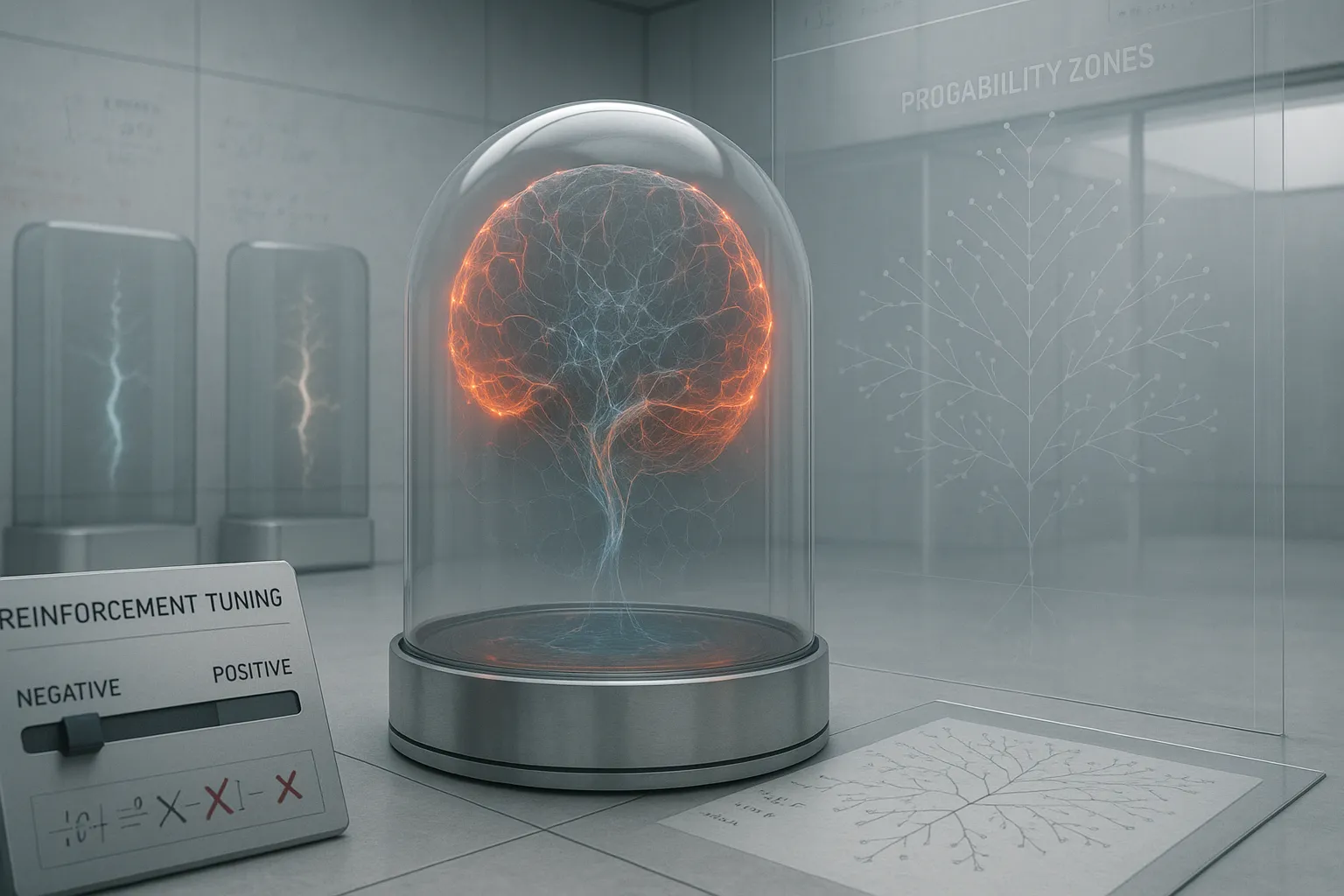💡 TL;DR - The 30 Seconds Version
🤯 Princeton and UVA researchers found AI models learn math better when punished for wrong answers than rewarded for correct ones.
📊 Models trained only on negative feedback achieved 53.3% success on hard math problems versus 43.3% for standard methods.
🔍 Negative reinforcement preserves solution diversity while positive reinforcement makes models overconfident and narrow in their thinking.
⚖️ Their new Weighted-REINFORCE method combines both approaches with 90% weight on punishment and 10% on rewards.
🧠 The technique works by teaching AI what not to do while letting existing knowledge guide exploration of alternatives.
🚀 This challenges core assumptions about AI training and could change how we teach machines across many fields.
Researchers at Princeton and the University of Virginia found something strange when training AI models to solve math problems. Teaching the system by punishing wrong answers worked better than rewarding correct ones.
This goes against what most people expect. We usually think positive reinforcement beats negative reinforcement. Tell someone they did well, and they'll do it again. Tell them they messed up, and they might shut down.
But AI models don't work like people. The research team split standard training methods into two parts. One approach rewarded correct answers. The other penalized mistakes. Then they tested each method separately on math reasoning tasks.
The results surprised them. Models trained only on punishment consistently outperformed those trained only on rewards. The punishment-trained models did better across every metric the researchers tested.
Why Punishment Beats Praise
The key lies in how AI models generate multiple solutions to problems. When you reward correct answers, the model becomes overconfident. It narrows down to a few "safe" responses and stops exploring alternatives.
When you punish wrong answers, something different happens. The model learns to avoid specific mistakes but keeps exploring other possibilities. It redistributes probability to alternative solutions the model already considers plausible.
Think of it like pruning a tree. Cutting away dead branches doesn't tell the tree exactly where to grow new ones. But it does redirect energy toward healthier parts that were already developing.
The researchers tested their approach on two advanced AI models: Qwen2.5-Math-7B and Qwen3-4B. They used the MATH dataset, which contains 7,500 mathematical problems that challenge even smart humans.
The Diversity Problem
Traditional training methods face a trade-off. They can make models more accurate on single attempts but less creative when allowed multiple tries. This matters because many real-world applications benefit from AI systems that can generate several good solutions.
Models trained with positive reinforcement alone showed this exact pattern. They got better at producing one correct answer but worse at generating diverse alternatives. Their success rate on single attempts went up, but their performance dropped when researchers measured success across multiple attempts.
Models trained with negative reinforcement maintained both accuracy and diversity. They performed well on single attempts and even better when allowed multiple tries. At the highest number of attempts tested, they often matched or beat the original untrained models.
The Technical Breakthrough
The research team dug deeper into why this works. They analyzed what happens at the level of individual words and tokens when the model learns.
Positive reinforcement sharpens the model's focus on specific correct paths. It increases the probability of tokens that appeared in successful solutions while decreasing everything else. This creates a feedback loop that makes the model increasingly confident in a narrow set of responses.
Negative reinforcement works differently. It decreases the probability of tokens that appeared in failed solutions but redistributes that probability based on what the model already considers plausible. The model learns what not to do while preserving its existing knowledge about what might work.
This explains why negative reinforcement preserves diversity. Instead of forcing the model toward specific solutions, it guides it away from known failures while letting the model's prior knowledge determine where to explore next.
A Better Balance
The researchers developed a simple fix called Weighted-REINFORCE. Instead of using pure positive or negative reinforcement, they combined both approaches but gave more weight to the negative signals.
They tested this hybrid method on three challenging math datasets: MATH, AIME 2025, and AMC23. The weighted approach consistently outperformed standard training methods including PPO and GRPO, two widely used techniques in AI training.
The improvement wasn't marginal. On some tests, the new method achieved the best results across nearly every metric. It matched the accuracy benefits of positive reinforcement while maintaining the diversity benefits of negative reinforcement.
Beyond Math Problems
This research focused on mathematical reasoning, but the implications reach further. Many AI applications require systems that can generate multiple good solutions rather than converging on a single answer.
Code generation, creative writing, and complex problem-solving all benefit from diversity. If negative reinforcement helps preserve this diversity while improving accuracy, it could change how we train AI systems across many domains.
The findings also challenge assumptions about learning more broadly. While positive reinforcement works well for humans in most contexts, AI systems might need different approaches. Their ability to process multiple possibilities simultaneously means they can benefit from being told what not to do rather than what to do.
Looking Forward
The research reveals something important about how AI learns. These systems already contain vast knowledge from their initial training. The question becomes how to guide that knowledge without destroying its richness.
Traditional approaches focused on amplifying correct behaviors. This new research suggests that suppressing incorrect behaviors might be more effective. It's the difference between telling someone exactly what to say versus teaching them what not to say and letting their judgment fill in the rest.
The technique works particularly well with models that already have strong reasoning abilities. For weaker models, the researchers found that pure negative reinforcement could lead to problems over time. The sweet spot seems to be combining both approaches with emphasis on the negative signals.
Why this matters:
- This challenges the assumption that positive reinforcement is always better than negative reinforcement for learning
- AI systems might need fundamentally different training approaches than humans because they process information differently
Read on, my dear:
❓ Frequently Asked Questions
Q: How long did the researchers train these AI models to see these results?
A: The researchers used 7,500 math problems from the MATH dataset for training. They generated 8 responses per problem with a batch size of 1,024 prompts. The exact training duration isn't specified, but they tested models at various checkpoints to track performance changes over time.
Q: Does this negative reinforcement approach work for other types of AI tasks besides math?
A: The study focused only on mathematical reasoning tasks. The researchers note that tasks requiring diverse solutions like code generation and creative writing might benefit, but they haven't tested this. The approach works best when correctness can be verified automatically.
Q: What specific models did they test, and are these available to researchers?
A: They tested Qwen2.5-Math-7B and Qwen3-4B models. Both are open-source models from the Qwen family known for strong reasoning abilities. The researchers chose these because they wanted models with existing mathematical knowledge to build upon.
Q: What happens if you train a model with only negative reinforcement for too long?
A: Performance drops after hundreds of training steps with pure negative reinforcement. The researchers found that models need some positive signals to maintain stability. Their Weighted-REINFORCE method combines both approaches with 90% weight on negative signals and 10% on positive ones.
Q: How much better is this new method compared to current AI training techniques?
A: On the AIME 2025 benchmark, their Weighted-REINFORCE method achieved the best results across nearly all metrics. When allowing 256 attempts, negative reinforcement alone reached 53.3% success compared to 43.3% for standard PPO training and 46.7% for the untrained model.








